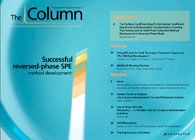Salt deserts
How cells survive, replicate and maintain genome integrity in high NaCl concentrations has long puzzled scientists. A group of US scientists has conducted a series of experiments to determine how this occurs and discovered that cells are actually protected from these conditions by the ?gene deserts?, the 40% of the genome that are thought to serve no purpose.

How cells survive, replicate and maintain genome integrity in high NaCl concentrations has long puzzled scientists. A group of US scientists has conducted a series of experiments to determine how this occurs and discovered that cells are actually protected from these conditions by the ‘gene deserts’, the 40% of the genome that are thought to serve no purpose.1
High concentrations of NaCl can lead to the breakdown of DNA within a genome. The breaks remain elevated for as long as NaCl concentration remains high and are rapidly repaired when the concentration is lowered. Repair of the breaks once NaCl is reduced is accompanied by formation of foci containing phosphorylated H2AX (γH2AX), which occurs around DNA double‑strand breaks and assists in their repair.
To investigate exactly what happens when a cell is exposed to high NaCl conditions, the team used a comet assay and pulsed field electrophoresis and confirmed that cells adapted to high NaCl have increased levels of double-strand breaks. γH2AX is predominantly localized to regions of the genome devoid of the genes – that is the gene deserts – which indicates that the high NaCl-induced double-strand breaks are located there. This localization to gene deserts helps to explain why the DNA breaks are less harmful than the random breaks induced by genotoxic agents. The team concluded that the presence of high salt levels around animal cells has directly influenced the evolution of the structure of their genomes.
1 Burg et al., Proceedings of the National Academy of Sciences, 108(51), 20796–20801 (2011).
This story originally appeared in The Column. Click here to view that issue.

New TRC Facility Accelerates Innovation and Delivery
April 25th 2025We’ve expanded our capabilities with a state-of-the-art, 200,000 sq ft TRC facility in Toronto, completed in 2024 and staffed by over 100 PhD- and MSc-level scientists. This investment enables the development of more innovative compounds, a broader catalogue and custom offering, and streamlined operations for faster delivery. • Our extensive range of over 100,000 high-quality research chemicals—including APIs, metabolites, and impurities in both native and stable isotope-labelled forms—provides essential tools for uncovering molecular disease mechanisms and exploring new opportunities for therapeutic intervention.
New Guide: Characterising Impurity Standards – What Defines “Good Enough?”
April 25th 2025Impurity reference standards (IRSs) are essential for accurately identifying and quantifying impurities in pharmaceutical development and manufacturing. Yet, with limited regulatory guidance on how much characterisation is truly required for different applications, selecting the right standard can be challenging. To help, LGC has developed a new interactive multimedia guide, packed with expert insights to support your decision-making and give you greater confidence when choosing the right IRS for your specific needs.

.png&w=3840&q=75)

.png&w=3840&q=75)



.png&w=3840&q=75)



.png&w=3840&q=75)











